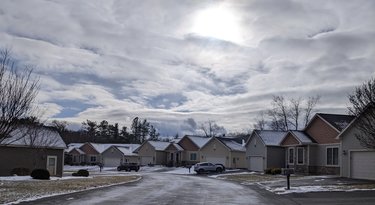Speakers call for small houses rather than large apartment complexes
The Enterprise — Melissa Hale-Spencer
Stone Creek Estates, in New Scotland, was built to offer affordable housing for people 55 and older who were downsizing and wanted to stay in town. Houses initially sold for $299,990 and now sell in the half-million-dollar range.
GUILDERLAND — Just four people spoke at the town board’s first hearing on Guilderland’s updated comprehensive plan. Three of them are frequent speakers at board meetings.
Karen White said she was “speaking to the people at home” during the Feb. 4 session, which is broadcast live and also videotaped.
“Please get off the couch,” said White, “and either come to a meeting or write a letter; do invest some time because by this summer it’ll be too late.”
White went on, “Think about what’s important in terms of quality of life and how you want the town to go … Don’t be apathetic. Don’t think somebody else is going to do it …. Don’t wait until, you know, the heavy equipment rolls into your neighborhood and then wonder what’s going on. Figure it out and get here.”
The board voted to extend its hearing until March 18. The public may also submit written comments; none were submitted before the Feb. 4 hearing.
The morning after the hearing, on Feb. 5, Supervisor Peter Barber reported at a chamber of commerce event on the poor hearing turnout.
“I think we had maybe five or six people speak,” he said. “We have thirty-seven-, thirty-eight-thousand people in our town. I would hope we get more than five people to show up and provide us with some assistance on it.”
A committee of nine residents worked with MJ Engineering for two years on updating the town’s two-decades-old plan.
“The comprehensive plan is a vision and a blueprint for the future of the town,” Jaclyn Hakes, diretor of planning for MJ Engineering, told the board before the start of the hearing.
The 198-page plan is available on the town’s website and in hard-copy form at the Guilderland Town Hall, the Altamont Village Hall, and the Guilderland Public Library.
Hakes said that 635 residents responded to a survey and others attended focus groups and open houses.
She highlighted “four key take-aways”:
— “The town is growing …. it’s important to allow for that growth, to create opportunities for different types of housing and protection of natural resources”;
— Western Avenue “serves as the de facto main street for the town.” There are opportunities for redevelopment and enhanced pedestrian facilities;
— “There is no single community character.” Rather, the town is a mix of different land types and character. The character of rural western Guilderland is addressed differently in the plan that suburban neighborhoods or compact historic hamlets; and
— Connections — as Guilderland is both aging and growing, the plan focuses on extending a trail network to connect neighborhoods and offer an alternative to driving.
Three of the four speakers at the hearing had similar comments on housing.
John Haluska said, “We’re really in a housing caste system.” He said less costly houses are needed, both for elderly residents who want to stay in town and for young people, looking to buy their first home.
He cited an Altamont Enterprise story on rural Westerlo promoting accessory-dwelling units, small cottage-like structures built in backyards.
Haluska suggested designating tracts of land for small, less expensive homes in Guilderland, “opening up the housing market to a group of folks that don’t have access to this housing market right now.”
Robyn Gray, who chairs the Guilderland Coalition for Responsible Growth and is another regular commenter at town board meetings, agreed with Haluska.
She said Guilderland has a lot of “higher end” apartments, citing the rental prices of various senior facilities in town. She concluded affordable housing for seniors “is very much lacking as is affordable housing just for the general population.”
Gray cited the 1.5-percent growth for Guilderland by 2030 with another 1.5-percent by 2040 described in the updated plan, which she calculated means an increase of 550 in population in each of those time periods.
Gray asserted that Guilderland apartment complexes currently have more vacancies than that.
“We have vacancies all over,” said Gray, stating that seniors “don’t want an apartment, they want a home,” which is small and manageable.
She and her husband, Gray said, “adapted our home because we plan to be carried out in bags.”
The town, she said, needs to focus on small homes and ADUs rather than big apartment complexes that don’t have elevators.
Gray also objected to the plan’s suggestion that the intersection of routes 20 and 155 would serve as a town center. “You’ve got six lanes on two of those roads at an intersection,” she said.
She suggested instead the “little cluster” of the public library and the YMCA, “places where people can meet,” would make sense as a town center.
Karen White, who also frequently addresses the board, again highlights vacancies at high-priced apartment complexes in Guilderland.
She cited a recent Altamont Enterprise article on senior housing in Guilderland and said, “We really have more than what we need of these massive people warehouses.”
Agreeing with Haluska, White said, “People really are looking for some … place to put down their roots, identity. They don’t want to live in a unit … Please no more massive empty buildings.”
David Bourque provided a fresh voice and different perspective.
A Guilderland resident for 60 years, he currently lives in Altamont and is president of Historic Altamont. One of the not-for-profit group’s goals, he said, “is to create a green zone around Altamont.”
Bourque, however, told the board he was not speaking for Historic Altamont but rather “as a neighbor, as a citizen, and as a local resident.”
Bourque said, “The lack of public water in the Altamont area is the one thing that has saved Altamont from being overdeveloped. Altamont has a huge target on it right now.”
He said the flat, agricultural land around the village “is ready for the developer’s shovel …
As soon as we put that connection in, he said of a waterline to Guilderland, “everybody’s going to want to tap into it, and the suburban sprawl will move from Western Avenue through Guilderland Center and out into Altamont … We need to resist that urge.”
Bourque concluded, “Let’s not sacrifice what makes the rural parts of Guilderland so unique, to allow developers to come in and mow it down.”
Other business
In other business at its Feb.4 meeting, the Guilderland Town Board:
— Accepted the offer of dedication of 24.59 acres as part of the approval for the Hamilton Parc Senior Facility.
“All stipulated work, including a bridge over the Kaikout Kill and multi-use trails throughout the property, has been installed,” said Town Engineer Jesse Fraine in a memorandum to the board.
“At some point, it will be a town park ….,” said Barber. “We want to make sure there’s rules in place for visiting the pond and whatnot.’
He also said, “The Albany Pine Bush Commission is very interested in this land because it’s a rare situation in which you have a pond with grasslands nearby, which are very good for particular types of birds and whatnot”; and
— Created a Conservation Overlay Zoning Committee, and appointed these members: Laura Barry, planning board member; Caitlin Ferrante, chairwoman of the Conservation Advisory Council; Jeff Perlee, Albany County legislator; Ken Kovalchik, town planner; and Supervisor Barber.
“We want to make sure that there are conservation overlay districts that protect both water, but also visual impacts,” said Barber.
He said more people will be added to the committee and “it’s the first time I actually appointed myself to a committee.”




It is noted here that " The public may also submit written comments; none were submitted before the Feb. 4 hearing" I DID send a detailed letter to the board members and specifically requested that it be included in the file for the 2/4 Public Hearing on the Comprehensive Plan.
I have since followed up with another email and have had no response from any board member, again, as of today.